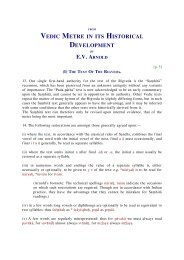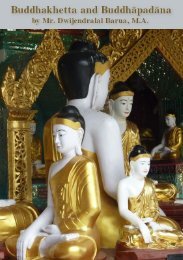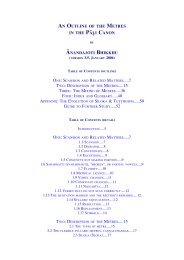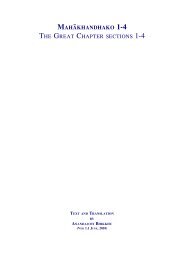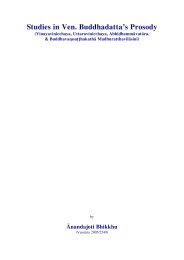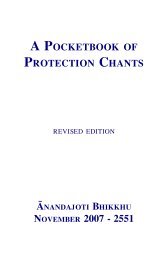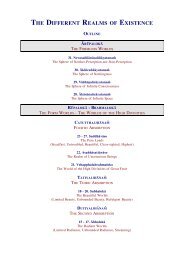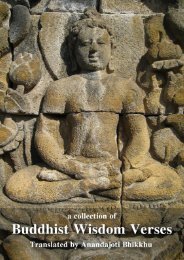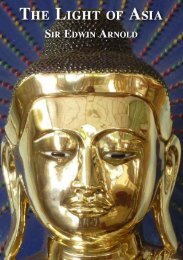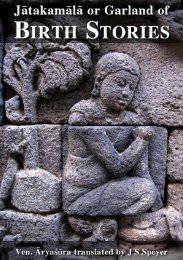Pubbakammapilotika-BuddhÄpadÄnaá¹ - buddhanet
Pubbakammapilotika-BuddhÄpadÄnaá¹ - buddhanet
Pubbakammapilotika-BuddhÄpadÄnaá¹ - buddhanet
You also want an ePaper? Increase the reach of your titles
YUMPU automatically turns print PDFs into web optimized ePapers that Google loves.
Introduction<br />
ChS: Burmese edition, as found on the Chaṭṭha Saṅgāyana CD-ROM (version 3, Igatpuri, no<br />
date, but = 1999).<br />
PTS: European edition, from Visuddhajanavilāsiṇī nāma Apadānaṭṭhakathā, edited by C. E.<br />
Godakumbara, Pali Text Society, London, 1954.<br />
As the notes to the edition clearly show there is a close relationship between ChS and Thai on<br />
the one hand; and SHB and PTS on the other. Indeed in each case the latter text appears to be<br />
taking the former as its model and only correcting it occasionally.<br />
2. The Relationship between the Text and the Commentary<br />
The Apadāna is organised into four sections: Buddhāpadāna (81 3<br />
verses);<br />
Paccekabuddhāpadāna (58 verses); Therāpadāna (6311 verses, 559 Theras) and Therī-Apadāna<br />
(1336 verses, 40 Therīs). 4<br />
The texts which are translated here describe the previous deeds of the Buddha which led in his<br />
last life to various kinds of suffering: from spending a long time in the wasteland of severe<br />
austerities; to receiving slander at various hands; to physical ailments of various kinds: being<br />
attacked and cut by rocks and scalpels; and getting headaches, backaches and dysentry.<br />
We may have expected them to be presented therefore in the Traditions about the Buddha<br />
(Buddhāpadāna), which begins the book. Instead we find them tucked away in a very odd place:<br />
right in the middle of the verses which are otherwise concerned with the Elders, as No. 390 of<br />
that collection.<br />
Why they are there is hard to explain, and it almost looks like someone was trying to hide<br />
them. There is a very short commentary on the opening verses at that place, 5 but the main<br />
commentary occurs at the end of the Traditions about the Buddha (Buddhāpadānasaṁvaṇṇanā),<br />
which suggests that either the verses were once there, or the commentator wanted to draw<br />
attention to them.<br />
The commentary on these verses is curious as it is unlike other sections of the same work<br />
which only provide a word commentary (vaṇṇanā). Here though, we get the stories explaining<br />
the deeds the Buddha-to-be had performed in the past, 6 which were finding their fulfilment,<br />
even when he was Buddha.<br />
Also it should be mentioned that the commentary doesn't take the verses in the order they<br />
appear in the text, but has them in roughly chronological order. To give an example, although<br />
the text treats the austerities that the Buddha-to-be underwent last, in the commentary it is<br />
dealt with first. 7<br />
Another problem is that there is some confusion in the commentary to verse two, as the story<br />
doesn't fit in with the verse it is supposed to explain. 8 The story at the beginning is about a<br />
scoundrel called Munāḷi, who slandered the Independent Buddha Surabhi. The verse, however,<br />
says that the Buddha-to-be had accused a disciple of the Buddha Sabbābhibhu called Nanda,<br />
3<br />
Verse numbers are as in the Sri Lankan edition.<br />
4<br />
Note that the last section has no commentary on it.<br />
5<br />
Not translated here as it is basically a word-commentary (vaṇṇanā), and is seperated from the rest of<br />
the commentary.<br />
6<br />
As in, for instance, the Jātakaṭṭhakathā.<br />
7<br />
The commentary treats them in the order: 12, 2, 1, 3, 4, 5, 6, 7, 8, 9, 10, 11.<br />
8<br />
Masefield noted this in his comments to the verses in the Udāna Commentary.<br />
4



